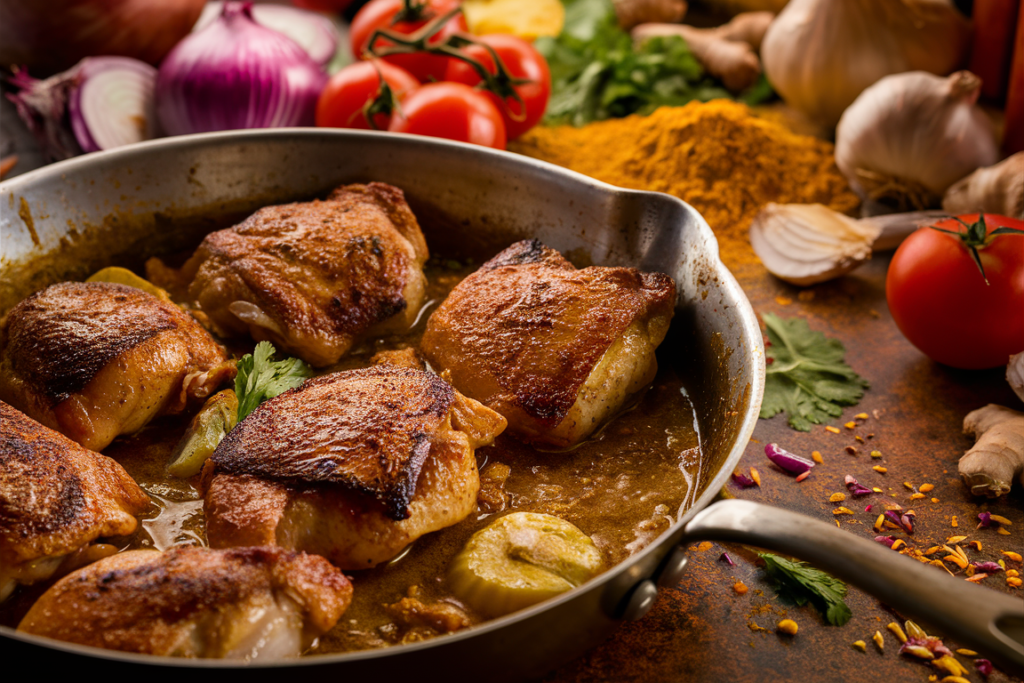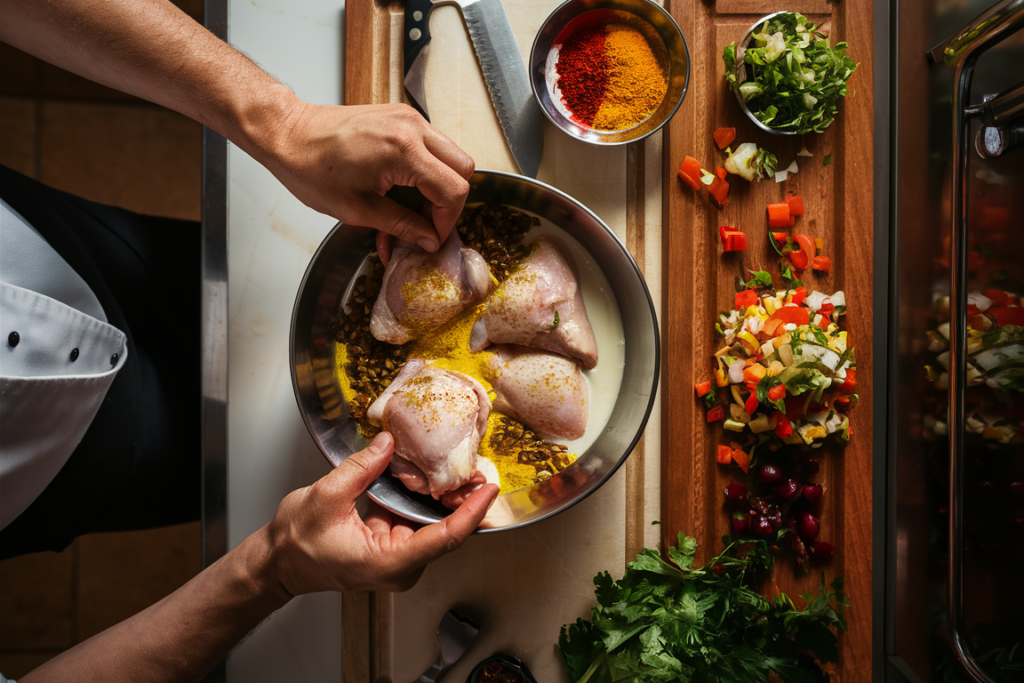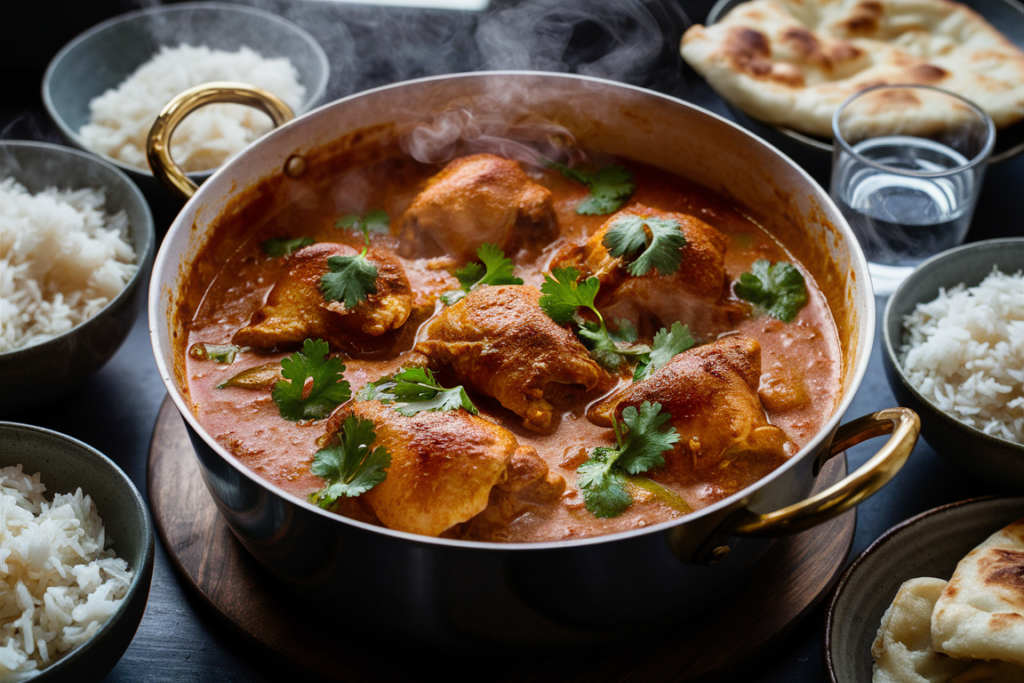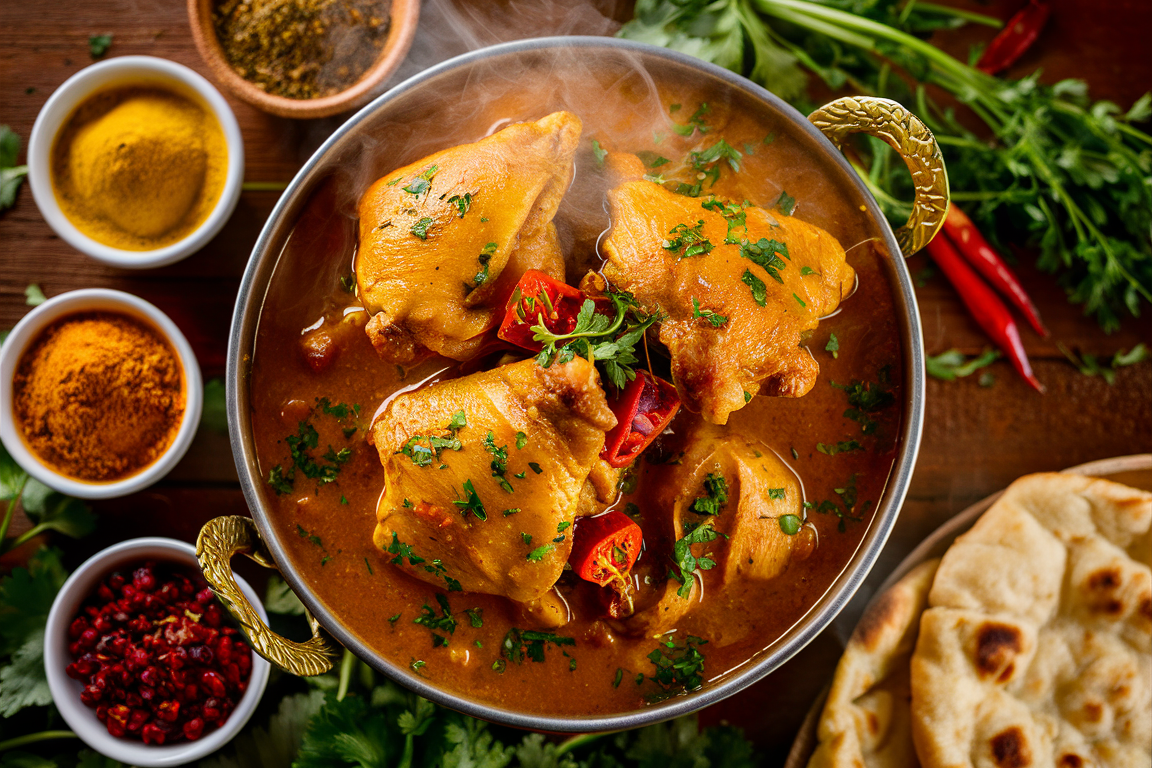Part1: Introduction to Chicken Thigh Curry
Chicken Thigh Curry is more than just a dish; it’s an aromatic symphony of spices and flavors that represents the diversity of culinary traditions worldwide. Whether you’re a seasoned home cook or a beginner, mastering this recipe opens doors to exploring various global cuisines. But why chicken thighs, and what makes them the perfect choice for curry?

What Makes Chicken Thigh Ideal for Curry?
Chicken thighs are rich in flavor, tender in texture, and resilient during long cooking processes. Unlike chicken breasts, which can easily dry out, thighs retain their juiciness, making them the star of many curry recipes.
- Fat Content: Chicken thighs have a higher fat content, enhancing the richness of your curry.
- Texture: They remain succulent even when simmered for extended periods.
- Flavor Absorption: Their structure allows spices to seep in deeply, creating a more flavorful bite.
By choosing chicken thighs, you’re ensuring your curry stays moist and flavorful. Plus, they are often more cost-effective, making them a practical choice for home chefs.
Origins and Variations of Curry
The word “curry” originates from the Tamil word kari, which means sauce or relish. Its roots can be traced back to South Asia, but over time, curry has evolved into a global phenomenon, adapting to the unique spices and techniques of different cultures.
- Indian Curries: Feature a blend of ground spices such as turmeric, cumin, coriander, and garam masala.
- Thai Curries: Known for their creamy coconut milk bases and vibrant additions like lemongrass and galangal.
- Caribbean Curries: Infused with tropical flavors such as allspice, Scotch bonnet peppers, and curry powder.
Each region’s curry offers a distinct taste profile, ensuring there’s something for everyone.
Nutritional Benefits of Using Chicken Thighs
Chicken thighs aren’t just flavorful; they’re packed with essential nutrients.
- Protein Power: A single thigh contains around 25 grams of protein, supporting muscle growth and repair.
- Rich in Iron and Zinc: These minerals are vital for maintaining a healthy immune system.
- Collagen Content: Perfect for those seeking to improve joint and skin health.
When paired with wholesome spices like turmeric (anti-inflammatory) and garlic (immune-boosting), your Chicken Thigh Curry becomes a nutritional powerhouse.
Key Ingredients in Chicken Thigh Curry
To create an unforgettable Chicken Thigh Curry, understanding the role of each ingredient is crucial.
Spices and Their Role in Flavor
Spices are the soul of any curry. Each spice contributes to a complex flavor profile:
- Turmeric: Adds warmth and a vibrant yellow hue.
- Cumin: Lends an earthy aroma.
- Coriander: Balances the heat with citrusy notes.
- Chili Powder: Provides the desired level of spice.
- Garam Masala: A finishing spice blend that enhances the overall flavor.
Freshly ground spices are essential for maximum potency and aroma, so consider investing in a spice grinder for your kitchen.
Choosing Fresh Chicken Thighs
Selecting quality chicken thighs ensures your curry tastes its best. Here are some tips:
- Skin-on vs. Skinless: Skin-on thighs add richness to the dish, while skinless is a leaner option.
- Bone-in vs. Boneless: Bone-in thighs enhance the depth of flavor during cooking.
- Freshness Check: Look for pinkish, moist flesh with no unpleasant odor.
Opt for organic or free-range chicken thighs if possible for a more ethical and flavorful choice.
Types of Chicken Thigh Curry
Chicken Thigh Curry adapts beautifully to various cuisines, each offering a unique taste experience.
Classic Indian Chicken Thigh Curry
This dish is deeply aromatic, featuring a rich base of onions, tomatoes, and yogurt. Key spices include:
- Garam Masala
- Fenugreek
- Mustard Seeds
Pair it with naan or basmati rice for an authentic Indian feast.
Thai Coconut Chicken Thigh Curry
Creamy, fragrant, and slightly sweet, this variation uses:
- Coconut Milk: For a luxurious base.
- Lemongrass and Kaffir Lime Leaves: To add a citrusy zest.
- Thai Red Curry Paste: For heat and depth.
This curry pairs wonderfully with jasmine rice and a fresh cucumber salad.
Caribbean Spiced Chicken Thigh Curry
Bursting with tropical flavors, this curry incorporates:
- Curry Powder: A blend unique to Caribbean cuisine.
- Scotch Bonnet Peppers: For a fiery kick.
- Allspice and Thyme: Adding warmth and herbaceous notes.
Serve it alongside fried plantains or rice and peas for a true island experience.
Part 2: Preparing for Chicken Thigh Curry
Preparation is the foundation of any great dish, and Chicken Thigh Curry is no exception. From selecting the right equipment to prepping your chicken thighs and curry base, this section will guide you through every essential step.

Equipment Needed for Cooking
To achieve a rich, flavorful Chicken Thigh Curry, you’ll need the right tools. Investing in quality kitchen equipment will ensure your curry is cooked evenly and infused with maximum flavor.
Essential Utensils for Curry Preparation
- Heavy-bottomed Pan or Dutch Oven: Ideal for even heat distribution, preventing your curry from burning or sticking.
- Sharp Chef’s Knife: Ensures precise cuts for both chicken and vegetables.
- Cutting Board: Preferably separate boards for meat and vegetables to avoid cross-contamination.
- Wooden Spoon or Silicone Spatula: Helps in stirring the curry without damaging your cookware.
- Mortar and Pestle (Optional): Perfect for grinding fresh spices for a more authentic flavor.
Having these tools ready will make the cooking process smoother and more enjoyable.
Prepping Chicken Thighs
The way you prepare your chicken thighs can significantly affect the flavor and texture of your curry. Let’s dive into the details.
Skin-On vs. Skinless Chicken Thighs
- Skin-On Thighs: Add extra richness to the curry due to the rendered fat, making it perfect for indulgent recipes.
- Skinless Thighs: A healthier option that allows the spices to penetrate the meat more directly.
Both options work well, but skin-on thighs are better suited for frying or browning before simmering in the curry.
Marination Techniques for Maximum Flavor
Marinating chicken thighs is the key to infusing flavor deep into the meat. A well-marinated chicken thigh creates a noticeable difference in your curry. Here’s a basic but effective marinade:
- Yogurt or Coconut Milk: Acts as a tenderizer and helps the spices adhere.
- Spices: Use turmeric, cumin, and chili powder.
- Acid: Lemon juice or vinegar brightens the flavors.
Let the chicken marinate for at least 30 minutes, but overnight is ideal for the most flavorful results.
Preparing the Base for Curry
The curry base sets the stage for all the flavors to come together. A rich, flavorful base makes all the difference in your final dish.
Traditional Onion and Tomato Base
This is a staple for Indian-style curries:
- Onions: Finely chopped and caramelized to add sweetness.
- Tomatoes: Provide acidity and depth of flavor.
- Garlic and Ginger: Aromatics that form the foundation of any good curry.
The secret to a great onion-tomato base is patience. Allow the onions to caramelize fully and the tomatoes to cook down until they release oil, ensuring a deep, concentrated flavor.
Coconut Milk and Cream Bases
For Thai and Caribbean curries, the base revolves around the luxurious creaminess of coconut milk:
- Coconut Milk: Adds sweetness and richness.
- Coconut Cream: Intensifies the creaminess, ideal for a thicker curry.
Be sure to use high-quality, full-fat coconut milk for the best texture and flavor.
Alternative Curry Bases (Yogurt, Cashew, etc.)
If you’re looking to experiment, try these alternatives:
- Yogurt Base: Adds a tangy and creamy element, commonly used in North Indian curries.
- Cashew Paste: Blended cashews create a velvety, nutty base.
- Spinach or Greens: For a lighter, healthier curry, blend greens into your base.
Each base offers a unique twist, allowing you to tailor the curry to your preferences.
Cooking Chicken Thigh Curry
Now that the preparation is complete, it’s time to bring everything together. Cooking Chicken Thigh Curry is an art that requires layering flavors and mastering techniques.
Step-by-Step Cooking Instructions
- Brown the Chicken: Heat oil in your pan and sear the chicken thighs until golden brown. This step locks in the juices and adds depth of flavor.
- Prepare the Base: Sauté onions, garlic, and ginger until aromatic. Add spices and cook briefly to release their oils.
- Simmer the Curry: Add your liquid base (tomato, coconut milk, or yogurt), along with the chicken thighs. Simmer gently until the chicken is tender.
- Finishing Touches: Adjust the seasoning and garnish with fresh herbs like cilantro or basil.
Proper timing and technique are crucial to ensuring your curry develops complex flavors without overcooking the chicken.
Layering Flavors with Spices
To achieve a balanced and aromatic curry, spices must be added in stages:
- Whole Spices (e.g., cumin seeds): Temper them in hot oil at the start to release their aromas.
- Ground Spices (e.g., turmeric, chili powder): Add during the cooking of the base to blend with the onions and tomatoes.
- Finishing Spices (e.g., garam masala): Stir in during the last few minutes for a burst of freshness.
Layering the spices this way ensures a depth of flavor that builds as the curry cooks.
Simmering and Timing Tips
Simmering is where the magic happens. Keep these tips in mind:
- Low Heat: Allows the chicken to absorb the flavors without overcooking.
- Timing: Simmer for at least 20–30 minutes to develop a rich, flavorful curry.
- Thickening: If the curry is too thin, reduce it on low heat, or add a slurry of cornstarch and water for a thicker consistency.
The longer you let the curry sit, the better the flavors meld together.
Part 3: Cooking Chicken Thigh Curry: Mastering the Process
Cooking Chicken Thigh Curry is more than following a recipe—it’s about understanding the techniques and methods that make the dish burst with flavor. In this section, we’ll explore advanced cooking tips, customization options, and how to troubleshoot common issues.

Customizing Chicken Thigh Curry
One of the joys of making Chicken Thigh Curry is its flexibility. With simple adjustments, you can adapt the dish to suit your taste, dietary needs, or ingredients on hand.
Adjusting Spice Levels
The spice level of your curry can make or break the experience. Here’s how to get it just right:
- Milder Curry: Reduce or omit chili powder and opt for sweet spices like cinnamon or cardamom.
- Spicier Curry: Add fresh green chilies, cayenne pepper, or a dash of hot sauce.
- Balance Heat: A dollop of yogurt or a splash of coconut milk can mellow an overly spicy curry.
Pro tip: Always taste-test after adding spices to fine-tune the heat.
Adding Vegetables or Lentils
Vegetables and lentils not only boost the nutritional value but also add layers of texture to your curry:
- Popular Vegetables: Potatoes, bell peppers, spinach, and cauliflower pair well with chicken thighs.
- Legumes: Add red lentils or chickpeas for a heartier dish.
- Timing: Add quick-cooking vegetables (like spinach) toward the end, while sturdier ones (like potatoes) can be simmered with the chicken.
This approach allows you to create a well-rounded meal in a single pot.
Making It Dairy-Free or Vegan-Friendly Alternatives
For those with dietary restrictions, Chicken Thigh Curry can be easily adapted:
- Dairy-Free Options: Substitute yogurt with coconut milk or almond-based cream.
- Vegan Alternative: Replace chicken thighs with tofu, tempeh, or hearty vegetables like eggplant or mushrooms.
By tweaking the base and protein, you can enjoy the essence of curry while catering to dietary preferences.
Common Mistakes and How to Avoid Them
Even seasoned cooks can stumble when making curry. Here’s how to sidestep the most common pitfalls.
Overcooking Chicken Thighs
Chicken thighs are forgiving, but they can still dry out or become rubbery if overcooked. Avoid this by:
- Simmering on Low Heat: Keeps the meat tender and moist.
- Timing: Bone-in thighs take around 25–30 minutes to cook through, while boneless may only need 15–20 minutes.
- Resting: Let the curry sit for a few minutes after cooking to allow the flavors to settle.
Balancing Spices Properly
Getting the spice balance wrong can ruin the dish. To achieve harmony:
- Start Light: You can always add more spice, but it’s hard to remove it.
- Taste as You Go: Regular tasting helps fine-tune the balance.
- Counteract Mistakes: If it’s too spicy, add cream or sugar. If it’s bland, increase salt or acidic ingredients like lime juice.
Thickening Curry Correctly
A watery curry can be unappetizing. To achieve the perfect consistency:
- Reduce: Simmer uncovered to let excess water evaporate.
- Thickeners: Add cashew paste, coconut cream, or a slurry of cornstarch and water.
- Blending: Purée some of the curry base (onions and tomatoes) for a naturally thick sauce.
Consistency is key to a velvety, satisfying curry.
Serving and Storing Chicken Thigh Curry
Once your curry is ready, it’s time to serve and, if needed, store it properly to enjoy later.
Ideal Side Dishes for Chicken Thigh Curry
The right side dish can elevate your curry experience. Here are a few classics:
- Rice: Steamed basmati or jasmine rice soaks up the curry sauce beautifully.
- Flatbreads: Naan or roti are perfect for scooping up the curry.
- Salads: A cucumber and yogurt salad provides a refreshing contrast.
Side dishes not only enhance the meal but also create a balanced culinary experience.
Storing Leftovers
Chicken Thigh Curry often tastes better the next day as the flavors deepen. Follow these tips to store it:
- Refrigerate: Store in an airtight container for up to 3 days.
- Freeze: For longer storage, freeze in portions for up to 3 months.
- Reheat: Gently reheat on the stovetop, adding a splash of water or coconut milk to revive the sauce.
Proper storage ensures your curry remains fresh and flavorful.
Tips for Enhancing Your Curry Skills
If you’re looking to go beyond the basics, here are some pro-level tips to take your Chicken Thigh Curry to the next level:
- Experiment with Spices: Try whole spices like star anise or curry leaves for a unique twist.
- Layer Aromatics: Sauté onions, garlic, and ginger in stages to build depth of flavor.
- Rest Your Curry: Allow the curry to rest for at least 10 minutes after cooking to meld the flavors.
These advanced techniques ensure your curry stands out every time.
More FAQs
Here are answers to some common questions about making Chicken Thigh Curry:
- Can I use chicken breasts instead of thighs? Yes, but adjust the cooking time as chicken breasts can dry out quickly.
- How do I know when the chicken is cooked? The meat should reach an internal temperature of 165°F (74°C) and be tender to the fork.
- What’s the best oil for curry? Neutral oils like vegetable or canola work well, but ghee or coconut oil adds authentic flavor.
- Can I make curry without onions? Yes, substitute onions with blended leeks or omit them entirely for a lighter curry.
- How can I make my curry more aromatic? Toast spices in oil before adding them to the base.
- Is curry better with fresh or dried herbs? Fresh herbs like cilantro or basil are ideal for garnish, while dried herbs work best during cooking.
- What can I use instead of coconut milk? Try almond milk, cashew cream, or Greek yogurt for a different flavor.
- How do I prevent my curry from splitting? Add dairy-based ingredients like yogurt or cream at low heat and stir continuously.
- Can I use frozen chicken thighs? Yes, but thaw them completely before cooking for even results.
- How do I fix a curry that’s too salty? Add a splash of cream, a potato, or a bit of sugar to balance the saltiness.

